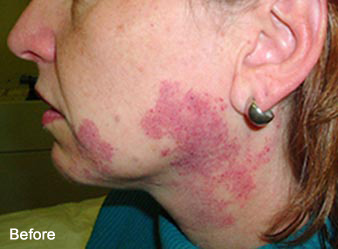Birthmarks
Port-wine stain & pigmentation birthmarks respond remarkably well to laser treatment.
Birthmarks
A birthmark is a congenital, benign irregularity on the skin which is present at birth or appears shortly after birth, usually in the first month. They can occur anywhere on the skin. Birthmarks are caused by overgrowth of blood vessels, melanocytes, smooth muscle, fat, fibroblasts, or keratinocytes.
The exact cause of most birthmarks is unknown, but they are thought to occur as a result of a localized imbalance in factors controlling the development and migration of skin cells. In addition, it is known that vascular birthmarks are not hereditary.
Port-Wine Stains
What is a Port-wine Stain?
Port-wine stain is a vascular malformation, which means it is a birthmark made of enlarged capillaries in the skin. Capillaries are tiny blood vessels in the body that connect the arteries and veins together. They are normally small and tiny. With enlarged capillaries, port-wine stain produces a red to purple discoloration of the skin.
Statistics on Port-wine stains
Port-Wine stains are present at birth at the rate of 0.1-0.3% of the population. This means it happens from 1-3 births in 1000 births. It can happen anywhere on the body. However it affects one side of the part of body in 85% of the cases.


Risk Factors for Port-wine stain
A Port-wine stain is usually not hereditary, and it does not have any racial or gender predisposition. It affects males and females equally.
Progression of Port-wine stain
Port wine stain appears as a flat birthmark, ranging from light pink to deep purple in color. It usually grows proportionately with age and become extremely unsightly in some cases. The lesion may become raised or bumpy as the patient achieves puberty. Later in life, the surface may become bumpy and uneven, and it may bleed easily. Port wine stain usually presents as an unsightly birthmark and does not fade over time.
How is Port-wine stain Treated?
There is no cure for port-wine stain, however it can be treated for cosmetic purposes so that it does not provide a psychological impact in later life. Cosmetic treatment of port-wine stain was often unsatisfactory before the development of laser technology. Currently, Nd-YAG laser therapy is used to treat port-wine stain. There are studies confirming its effectiveness in adults,children and infants with low side effects. Hence, laser therapy is currently the first-line treatment for port-wine stain.
Cafe’ au lait
What is a Cafe’ au lait Spot?
Café au lait spots or Café au lait macules are pigmented birthmarks. The name café au lait is French for “coffee with milk” and refers to their light-brown color.
Cafe’ au lait birthmarks don’t have a defined shape and can appear anywhere on the body. They really do look like someone spilled some coffee and cream on the skin. Cafe’ au lait birthmarks can be a small spot or, a very large patch.


A cafe’ au lait birthmark can change color over time and with sun exposure. It
can become very dark brown in comparison with the skin that surrounds the cafe’ au lait birthmark. Sunscreen can help minimize the darkening of a cafe au lait birthmark if it is on a part of the body that is exposed to sun.
Many people worry that a cafe’ au lait birthmark can turn cancerous, but this is not the case. Most cafe’ au lait birthmarks are harmless.

35 East Parade
Sutherland, NSW, 2232
(02) 9521 4267
Phone Sutherland Skin Cancer & Laser Clinic
info@skincancerandlaserclinic.com
Email Sutherland Skin Cancer & Laser Clinic
Call to Schedule a Consultation
Send us a message or give us a call at (02) 9521 4267
